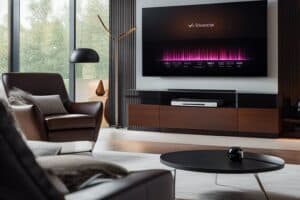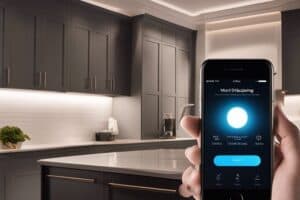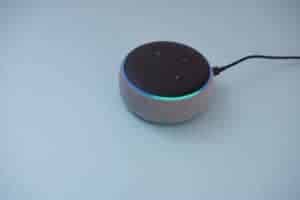The smart home is on the horizon, but it’s not what you might think. The future of this technology will feature a lot more automation than we’re used to and there are no clear-cut winners in sight.
The “high-tech houses of the future” is a smart home that has been around for quite some time. The technology in these homes is changing and improving everyday.
Aaaaaaaaaaaaaaaaaaa When is it going to happen? Oh, it’s already arrived.
Smart homes aren’t going away anytime soon. Although it may be a foreign notion to others, many individuals are already benefiting from it. The Internet is used in smart home technologies to link devices in a network. Automation is a procedure that allows for remote monitoring and control of these equipment. We’ll go further into what makes smart homes the future of our everyday life, even if it seems difficult.
A History of S.M.A.R.T.
The term “smart device” refers to any device that has intelligent characteristics or functions. The word “SMART” has a lengthy history. It all began with IBM’s proprietary technology standard a few decades back. S.M.A.R.T. stands for Self-Monitoring Analysis and Reporting Technology.
Mainframe drives received S.M.A.R.T. alerts for probable system faults. It looked for differences in the mechanical parts of the system and suggested replacements after the hard drive had moved out of tolerance. If you remember back when desktop computers had large CRT displays, you may recall seeing S.M.A.R.T. every time you turned on the machine.
S.M.A.R.T. technology has expanded beyond desktop computers to include appliances, cellphones, and other network-connected devices.
The Evolution of Automation Through the Internet of Things (IoT)
Households are gradually gaining access to smart home technologies, giving birth to phrases like ‘home automation’ and ‘domotics,’ both derived from the root word domus, which means “home.” Home automation allows equipment in a home to be controlled remotely. Temperature, lighting systems, household appliances, and home theater packages, to mention a few, may now be monitored and adjusted from a distance. The Internet serves as the lifeblood of home automation. Gateway hubs, such as wall-mounted terminals, laptops, internet interfaces, or smartphone applications, link smart devices. People may then access these gadgets through the internet via these gateway hubs. Because of this system’s dependence on the Internet, a phrase has been established to define its interconnectedness: the Internet of Things (IoT). The Internet of Things (IoT) is a notion that extends the Internet’s capabilities beyond traditional computers. It gives gadgets a way to communicate and interact with one another. The whole of these gadgets exceeds the sum of their components. Users benefit from additional valuable features as a result of this interconnection. Several parts of a home that were previously disregarded may now be linked online thanks to the Internet of Things. Home security monitoring systems, smoke detectors, refrigerators, door locks, washing machines, household cleaning robots, and energy usage meters are just a few examples.
Consumers are becoming more interested in home automation. The National Association of Home Builders published statistics on customer preferences for smart home devices in 2012. The top vote-getters were as follows:
- Wireless security systems account for 50% of all security systems.
- 47 percent of homes have programmable thermostats.
- Security cameras account for 40% of the total.
- 39 percent of people use wireless home audio systems and lighting control gauges.
- Bundles of home theater equipment save you 37%.
In 2013, the home automation sector was valued at $5.77 billion, which was a promising start. Since then, it has exceeded these figures, with a projected revenue of US$ 12.81 billion by 2020.
The first features of home automation were aimed to save time and effort. Wireless technologies and a proxy server were used in the initial generation of these smart gadgets. This has subsequently developed into artificial intelligence-controlled gadgets, such as Amazon’s Alexa. The research of robot utilization, such as Roomba and Robot Rovio, is the next frontier. The Internet of Things (IoT) is rapidly expanding. In addition to remote access and interconnectivity, the IoT may gather data on how these devices are used. These data may be mapped out to produce digital trends that can assist users and manufacturers in determining which features work and which need to be improved.
One of the primary advantages of implementing home automation is increased efficiency. Self-contained or preset-controlled devices may save more energy since they can switch themselves off when not in use. The Internet of Things has also been used to provide automatic help to those with impairments or elderly people who need assistance. Home systems may be customized to meet the requirements of individuals with certain impairments.
Voice control may be used to guide people with impairments who may be blind. Cochlear implants may provide alert alerts to those with hearing loss. Motion detection is also available in the event of a seizure or an accident.
Without the Internet of Things, these functions would be useless. The early results are promising; the Internet of Things has the potential to dramatically enhance people’s quality of life.
Cities that are smart
When many smart houses are clustered together in a neighborhood, the community may benefit from the synergy.
Smart cities take the notion of the smart home to the next level by incorporating the Internet of Things across the city. Various gadgets are linked together in a network to help with day-to-day municipal operations.
The Internet of Things has enormous potential when deployed on a bigger scale. Water supply networks, electricity grids, trash disposal, law enforcement, school databases, and hospital administration may all benefit from the collaboration of devices. It’s simpler to notice difficulties when you have a comprehensive system that encompasses all of these tasks.
Smart technology, such as information and communication technology (ICT), may also aid in improving the relationship between politicians and the general public. Data gathering systems can look into how people use various forms of technology. The analysis of this data will aid the city in responding more quickly to the demands of its citizens. They can also predict where the city will go in the future. For example, using IoT data, it is now feasible to determine if a city as a whole is becoming more ecologically conscious.
According to Mark Deakin and Husam Al Waer’s study, “From intelligent to smart cities,” there are four aspects that contribute to a community’s development into a smart city.
The first is the widespread use of electronic and digital technology. The next step is to employ ICT, or information and communication technology, to improve residents’ quality of life and working circumstances. As a third component, the application of these ICT to government operations is critical. Finally, citizen connectedness is critical for facilitating community dialogues.
The Internet of Things may contribute to the development of a smart city in a number of ways. When there is a digital payment platform, government transactions are easier to administer. Smart parking applications are used in several places to help individuals discover the most convenient parking spot in the city. This is made feasible by data gathered from lampposts equipped with sensors that monitor parking lots.
Smart applications have made it feasible to fulfill the needs of public transportation from ride-sharing apps to volume control in public transit systems when it comes to transportation. If traffic lights with sensors detect that roadways are getting crowded, they may change their performance accordingly.
A smart city is more than just a technological marvel. It’s about individuals and how ICT and smart technologies may help them enhance their quality of life.
Future Residences
Individual residences will profit from the rise of smart cities. Smart home technology is becoming more prevalent, and more gadgets are being created to be compatible with it.
A rise in demand might lower the cost of sensors, which are critical components of smart home technology. If it gets more common, these components will become more inexpensive and available to a larger number of individuals. This is critical in smoothing the move from luxury to standard for this technology.
While technological trends may shift at any time, we can be certain that individuals will always have a place to call home. For IT businesses, this constancy is reassuring; you can be certain that they will continue to create smart home gadgets.
Gartner, a research and consultancy firm, forecasts that by 2022, the average home will have more than 500 smart gadgets. People’s preferences for smart home technologies increased between 2014 and 2017, according to the research company Crimson Hexagon. Sixty percent of people want to incorporate these technology into their homes. These technologies, it is hoped, would make their lives simpler and potentially save them money.
This demonstrates how technology gets ingrained in people’s everyday lives over time.
Refrigerators, for example, were strange contraptions when they were first offered to the public in 1913. People nowadays are unlikely to be able to comprehend living without refrigeration in their homes.
In recent years, several technologies have grown more common in households. The smart speaker is currently one of the most popular products in American homes. One out of every six Americans, or around 39 million individuals, has one. They’re small, energy-efficient, and don’t need any unsightly cables.
Control Hubs for Smart Homes
One of the gadgets that may be connected to a home network is smart speakers. The living area is now being converted into a focal point. Lighting controls, thermostats, and door locks are all possible additions to this system. With the touch of a smartphone, homeowners can manage and monitor these gadgets.
Devices for Smart Home Display
With the possibility of screens that can fold up when not in use or high-definition projectors that can transform walls into temporary but powerful displays, display technologies may witness innovation as well.
Furniture and interior design software that is open source
There is already open source furniture accessible. You may be your own interior designer; if you have a certain furniture design in mind for your house, you can bring it to life using online platforms and applications like Hutch and Modsy.
Screenshot from Facebook
If you’re feeling lonely in your living room, Facebook is working on a smart camera that will make you feel like you’re sitting face-to-face with a loved one.
Keeping an eye on the elderly
Aside from these fascinating features, living room hubs may also serve as a home security precaution. Security cameras may be used to keep an eye on elderly parents. These video clips may be seen on smartphones at any time. There are also motion sensors that may notify people if someone in the house is having seizures or other similar problems.
Kitchens that are smart
In the kitchen, smart ovens contain digital thermometers that allow you to control the temperature of your meal while cooking. This is a function that ensures your cuisine does not overcook. It also serves as an extra layer of protection against fires.
Smart refrigerators can notify users if any of the product within is about to spoil. It may also supply cooking instructions and recipes if you need them right now.
There are also ice cream machines with sophisticated technology that can notify you whether the mixture in your sundae is firm enough. 3D food printers are now available to assist in the creation of almost any form of food component. There’s no limit to what you can do!
Bedrooms that are smart
There are a number of smart gadgets in the bedroom that may help you get a good night’s sleep. Smart thermostats are capable of adjusting the temperature to your preferences. Sleep trackers included into smart mattresses measure the quality of your sleep, enabling you to record your daily sleep hours and make adjustments. Every time you wake up, smart alarm clocks may give you with weather updates and news headlines.
There’s also an alarm system that uses aromatherapy to give you a soothing wake-up call. This device detects your sleeping pattern and emits a perfume of your choosing to arouse your senses.
Wardrobes and Mirrors with Intelligence
Smart gloves in your closet allow you to interact with your wardrobe by measuring skin temperature and selecting garments that match those readings. If your wardrobe is in need of an update, Amazon lets you to browse for items online and alter them using a clever proprietary mirror. If it’s merely a question of color, smart clothing that alter colours and tints based on your mood are now available.
Bathrooms with Intelligence
The smart home revolution includes the bathroom as well. Smart shower systems, such as U by Moen, may set your desired water temperature in advance using presets. Toto tubs may help you relax while showering by generating soothing brain waves. With applications like Olfinity, aromatherapy can be accessed with a flick of a smartphone.
Smart Technology’s Challenges
While smart homes provide luxury and convenience at the push of a button, they are not without flaws. Connectivity is one of the most significant roadblocks.
According to Statista, the Internet of Things (IoT) has enormous potential, with an estimated 75 million smart gadgets in diverse homes by 2025. However, there is the problem of interoperability, which is particularly important for gadgets from various tech firms. The connection standards remain disparate, necessitating the consolidation of everything into a single system to prevent compatibility difficulties.
Different devices have different network interfaces, and competing companies may make it difficult for their gadgets to communicate with one another. This is a problem that has to be resolved as quickly as possible in order to extend the potential of smart homes.
The Internet’s dependability is also an appealing touchpoint. These smart gadgets will not operate together in a network unless they have an active internet connection. Although it may be difficult to fathom living in a developed nation, there are still areas with poor Internet access. Because to a lack of infrastructure, at least 35 nations, including Guatemala, Honduras, and Nicaragua, have less than 20% Internet connectivity.
Expert brains are hard at work trying to solve the connection problem. There are plans for unified controllers that will allow smart gadgets in a house to operate together smoothly. If there is a single app or interface to handle IoT items for temperature control, lighting, security cameras, and power usage, it would be a major convenience for customers.
These control hubs should be built to work with the majority of current communication technologies, such as WiFi and Bluetooth.
Artificial intelligence-powered voice assistants are increasingly gaining traction as a viable connection option. Users will be able to operate their smart home systems more effectively as the number of gadgets that react to voice commands grows.
Smart home technology and the Internet of Things will become essential elements of everyday life, not simply a luxury for those who can afford it, if these connection issues are handled.
Future Decades with Bright Prospects
The smart home may seem ‘normal’ today, but its core concepts were once just the stuff of science fiction.
The tablet was nothing more than a throwback to 2001: A Space Odyssey’s gadget. Wearable technology like as smart eyeglasses, comparable to today’s Oculus Rift, was foreseen in the Back to the Future trilogy. Star Trek paved the way for wrist-worn gadgets that function similarly to cellphones.
Smart House, a Disney film from 1999, has a robot called PAT (short for Personal Applied Technology). This sentient entity effectively operates the home via voice instructions and has a superb memory for the people’ routines and dispositions.
An concept is the starting point for science. With the rate at which technology advances, it is not unreasonable to believe that these concepts will become fixtures of the future in the not-too-distant future. It raises the question: what can we anticipate in the next decades, such as the 2030s and 2040s, since we now have smart homes?
Experts in the field of smart homes make big forecasts. They predict that by the 2030s, the world’s population would have swelled to 8.5 billion people. Smart homes are well positioned to address overpopulation by promoting co-living as a viable option.
With the concept of private housing pods, shared living areas may even be transportable. During this decade, mental health may also be a hot topic. This difficulty could be alleviated via augmented reality and sociability through shared living areas.
The 2040s may be sophisticated enough to allow for the integration of robots into society, as we see in science fiction films today. Robotic creatures’ artificial intelligence may improve to the point that they can coexist with humans, if not outnumber them. There will be ethical challenges to address initially, but it is hoped that robots under development today would seek to enhance human life quality.
Optimism and Pessimism in Balance
Smart homes, like any new idea, will never be universally hailed as a success. There will be skepticism and misgivings. There will also be enthusiasm and results, particularly from those who have already reaped the advantages. But one thing is certain: smart homes will continue to be a worldwide trend for years, if not decades, to come.
In terms of current events, the Internet of Things is gaining popularity throughout the globe. According to the Crimson Hexagon artificial intelligence think tank’s 2018 Consumer Electronics Guide, attitudes toward smart gadgets are mainly favourable. As indicated by its exponential sales rise over the last seven years, voice assistants are becoming increasingly commonplace.
There are still worries about data breaches and privacy problems, particularly with home-connected internet networks. However, IT corporations are not wasting any time in responding to difficulties as they arise. Despite these concerns, statistics demonstrate that people like the convenience that smart homes provide.
This is a reassuring statement of confidence in the future of smart home technologies. Smart home technology is here to stay, and it will make the world a better place.
Watch This Video-
The “home of the future” is a concept that has been around for years. The idea of having your home be able to do more than just provide you with shelter and keep you warm, is something that people have dreamed of for a long time.
Frequently Asked Questions
What is the future of smart home technology?
A: For the foreseeable future, smart home technology will continue to rise in popularity. This is because it provides a convenient way for people to control their devices remotely and also saves energy by turning off or shutting down when not needed.
What is the future of home automation?
A: The future of home automation is highly dependent on how much progress we make in terms of artificial intelligence. There will be many different uses for smart homes, such as the ability to control your house with a smartphone app or use voice commands instead of pressing buttons.
How do you create a smart home in 2021?
A: The best way to create a smart home in 2021 is by purchasing the necessary equipment and learning how to use it. It will be expensive at first, but as technology improves, prices should fall over time.
Related Tags
- homes of the future 2050
- smart home research papers
- smart home trends 2030
- smart home innovations
- introduction to smart home









